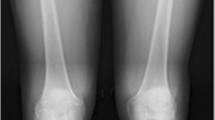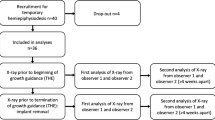Abstract
The use of accurate and reliable clinical and imaging modalities for quantifying leg-length discrepancy (LLD) is vital for planning appropriate treatment. While there are several methods for assessing LLD, we questioned how these compared. We therefore evaluated the reliability and accuracy of the different methods and explored the advantages and limitations of each method. Based on a systematic literature search, we identified 42 articles dealing with various assessment tools for measuring LLD. Clinical methods such as use of a tape measure and standing blocks were noted as useful screening tools, but not as accurate as imaging modalities. While several studies noted that the scanogram provided reliable measurements with minimal magnification, a full-length standing AP computed radiograph (teleoroentgenogram) is a more comprehensive assessment technique, with similar costs at less radiation exposure. We recommend use of a CT scanogram, especially the lateral scout view in patients with flexion deformities at the knee. Newer modalities such as MRI are promising but need further investigation before being routinely employed for assessment of LLD.
Level of Evidence: Level IV, diagnostic study. See the Guidelines for Authors for a complete description of levels of evidence.







Similar content being viewed by others
References
Aaron A, Weinstein D, Thickman D, Eilert R. Comparison of orthoroentgenography and computed tomography in the measurement of limb-length discrepancy. J Bone Joint Surg Am. 1992;74:897–902.
Aitken GF, Flodmark O, Newman DE, Kilcoyne RF, Shuman WP. Mack LA. Leg length determination by CT digital radiography. AJR Am J Roentgenol. 1985;144:613–615.
Altongy JF, Harcke HT, Bowen JR. Measurement of leg length inequalities by Micro-Dose digital radiographs. J Pediatr Orthop. 1987;7:311–316.
Aspegren DD, Cox JM, Trier KK. Short leg correction: a clinical trial of radiographic vs. non-radiographic procedures. J Manipulative Physiol Ther. 1987;10:232–238.
Badii M, Shin S, Torreggiani WC, Jankovic B, Gustafson P, Munk PL, Esdaile JM. Pelvic bone asymmetry in 323 study participants receiving abdominal CT scans. Spine. 2003;28:1335–1339.
Baylis WJ, Rzonca EC. Functional and structural limb length discrepancies: evaluation and treatment. Clin Podiatr Med Surg. 1988;5:509–520.
Beattie P, Isaacson K, Riddle DL, Rothstein JM. Validity of derived measurements of leg-length differences obtained by use of a tape measure. Phys Ther. 1990;70:150–157.
Cleveland RH, Kushner DC, Ogden MC, Herman TE, Kermond W, Correia JA. Determination of leg length discrepancy. A comparison of weight-bearing and supine imaging. Invest Radiol. 1988;23:301–304.
Defrin R, Ben Benyamin S, Aldubi RD, Pick CG. Conservative correction of leg-length discrepancies of 10 mm or less for the relief of chronic low back pain. Arch Phys Med Rehabil. 2005;86:2075–2080.
Fisk JW, Baigent ML. Clinical and radiological assessment of leg length. N Z Med J. 1975;81:477–480.
French SD, Green S, Forbes A. Reliability of chiropractic methods commonly used to detect manipulable lesions in patients with chronic low-back pain. J Manipulative Physiol Ther. 2000;23:231–238.
Glass RB, Poznanski AK. Leg-length determination with biplanar CT scanograms. Radiology. 1985;156:833–834.
Green WT, Wyatt GM, Anderson M. Orthoroentgenography as a method of measuring the bones of the lower extremities. J Bone Joint Surg Am. 1946;28:60–65.
Gurney B. Leg length discrepancy. Gait Posture. 2002;15:195–206.
Hanada E, Kirby RL, Mitchell M, Swuste JM. Measuring leg-length discrepancy by the “iliac crest palpation and book correction” method: reliability and validity. Arch Phys Med Rehabil. 2001;82:938–942.
Harris I, Hatfield A, Walton J. Assessing leg length discrepancy after femoral fracture: clinical examination or computed tomography? ANZ J Surg. 2005;75:319–321.
Helms CA, McCarthy S. CT scanograms for measuring leg length discrepancy. Radiology. 1984;151:802.
Horsfield D, Jones SN. Assessment of inequality in length of the lower limb. Radiography. 1986;52:223–227.
Huurman WW, Jacobsen FS, Anderson JC, Chu WK. Limb-length discrepancy measured with computerized axial tomographic equipment. J Bone Joint Surg Am. 1987;69:699–705.
Jonson SR, Gross MT. Intraexaminer reliability, interexaminer reliability, and mean values for nine lower extremity skeletal measures in healthy naval midshipmen. J Orthop Sports Phys Ther. 1997;25:253–263.
Kogutt MS. Computed radiographic imaging: use in low-dose leg length radiography. AJR Am J Roentgenol. 1987;148:1205–1206.
Konermann W, Gruber G. Ultrasound determination of leg length [in German]. Orthopade. 2002;31:300–305.
Krettek C, Koch T, Henzler D, Blauth M, Hoffmann R. A new procedure for determining leg length and leg length inequality using ultrasound. II: Comparison of ultrasound, teleradiography and 2 clinical procedures in 50 patients [in German]. Unfallchirurg. 1996;99:43–51.
Lampe HI, Swierstra BA, Diepstraten AF. Measurement of limb length inequality. Comparison of clinical methods with orthoradiography in 190 children. Acta Orthop Scand. 1996;67:242–244.
Leitzes AH, Potter HG, Amaral T, Marx RG, Lyman S, Widman RF. Reliability and accuracy of MRI scanogram in the evaluation of limb length discrepancy. J Pediatr Orthop. 2005;25:747–749.
Machen MS, Stevens PM. Should full-length standing anteroposterior radiographs replace the scanogram for measurement of limb length discrepancy? J Pediatr Orthop B. 2005;14:30–37.
Merrill OE. A method for the roentgen measurement of the long bones. Am J Roentgenol Radium Ther Nucl Med. 1942;48:405–406.
Millwee RH. Slit scanography. Radiology. 1937;28:483–486.
Moseley CF. Leg length discrepancy. In: Morrissy RT, Weinstein SL, eds. Lovell and Winter’s Pediatric Orthopedics. Philadelphia, PA: Lippincott Williams & Wilkins; 2006;1213–1256.
Okun SJ, Morgan JW Jr, Burns MJ. Limb length discrepancy: a new method of measurement and its clinical significance. J Am Podiatry Assoc. 1982;72:595–599.
Petrone MR, Guinn J, Reddin A, Sutlive TG, Flynn TW, Garber MP. The accuracy of the Palpation Meter (PALM) for measuring pelvic crest height difference and leg length discrepancy. J Orthop Sports Phys Ther. 2003;33:319–325.
Porat S, Fields S. Limb length discrepancy determined by computerized tomography and radiography [in Hebrew]. Harefuah. 1989;116:515–516.
Rhodes DW, Mansfield ER, Bishop PA, Smith JF. Comparison of leg length inequality measurement methods as estimators of the femur head height difference on standing Xray. J Manipulative Physiol Ther. 1995;18:448–452.
Rhodes DW, Mansfield ER, Bishop PA, Smith JF. The validity of the prone leg check as an estimate of standing leg length inequality measured by Xray. J Manipulative Physiol Ther. 1995;18:343–346.
Rondon CA, Gonzalez N, Agreda L, Millan A. Observer agreement in the measurement of leg length. Rev Invest Clin. 1992;44:85–89.
Sabharwal S, Badarudeen S, McClemens E, Choung E. The effect of circular external fixation on limb alignment. J Pediatr Orthop. 2008;28:314–319.
Sabharwal S, Zhao C, McKeon J, Melaghari T, Blacksin M, Wenekor C. Reliability analysis for radiographic measurement of limb length discrepancy: Full-length standing anteroposterior radiograph versus Scanogram. J Pediatr Orthop. 2007;27:46–50.
Sabharwal S, Zhao C, McKeon JJ, McClemens E, Edgar M, Behrens F. Computed radiographic measurement of limb-length discrepancy. Full-length standing anteroposterior radiograph comared with scanogram. J Bone Joint Surg Am. 2006;88:2243–2251.
Saleh M, Milne A. Weight-bearing parallel-beam scanography for the measurement of leg length and joint alignment. J Bone Joint Surg Br. 1994;76:156–157.
Shapiro F. Pediatric Orthopedic Deformities. Basic Science, Diagnosis, and Treatment. San Diego, CA: Academic Press; 2001;606–732.
Temme JB, Chu WK, Anderson JC. CT scanograms compared with conventional orthoroentgenograms in long bone measurement. Radiol Technol. 1987;59:65–68.
Terjesen T, Benum P, Rossvoll I, Svenningsen S, Floystad Isern AE, Nordbo T. Leg-length discrepancy measured by ultrasonography. Acta Orthop Scand. 1991;62:121–124.
Terry MA, Winell JJ, Green DW, Schneider R, Peterson M, Marx RG, Widmann RF. Measurement variance in limb length discrepancy: Clinical and radiographic assessment of interobserver and intraobserver variability. J Pediatr Orthop. 2005;25:197–201.
Tokarowski A, Piechota L, Wojciechowski P, Gajos L, Kusz D. Measurement of lower extremity length using computed tomography [in Polish]. Chir Narzadow Ruchu Ortop Pol. 1995;60:123–127.
Acknowledgments
We thank Dr. Caixia Zhao and Ms. Emily McClemens, PA-C, for their assistance in preparing this manuscript.
Author information
Authors and Affiliations
Corresponding author
Additional information
Each author certifies that he or she has no commercial associations (eg, consultancies, stock ownership, equity interest, patent/licensing arrangements, etc) that might pose a conflict of interest in connection with the submitted article.
About this article
Cite this article
Sabharwal, S., Kumar, A. Methods for Assessing Leg Length Discrepancy. Clin Orthop Relat Res 466, 2910–2922 (2008). https://doi.org/10.1007/s11999-008-0524-9
Received:
Accepted:
Published:
Issue Date:
DOI: https://doi.org/10.1007/s11999-008-0524-9




